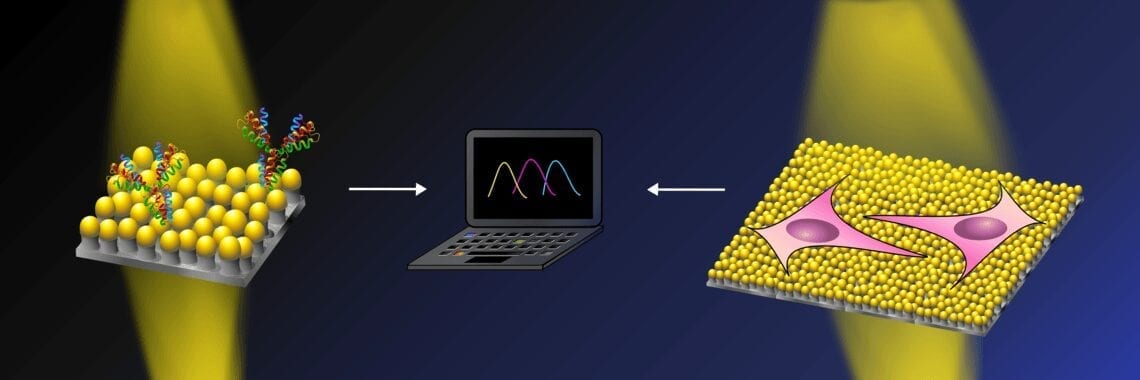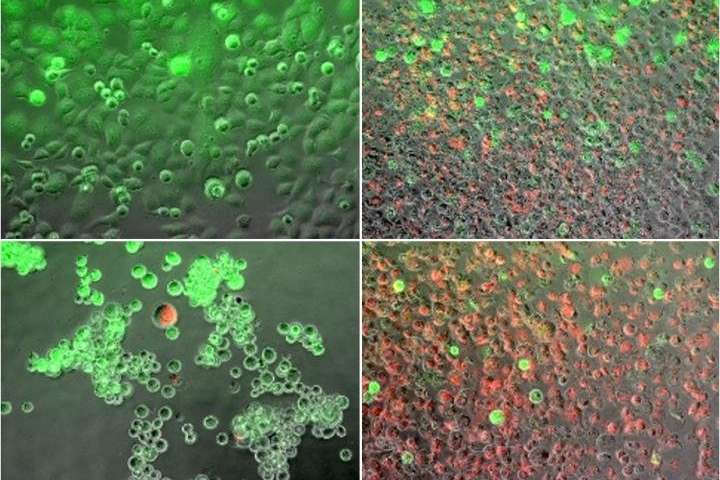
A small rectangle of pink glass, about the size of a postage stamp, sits on Professor Amy Shen’s desk. Despite its outwardly modest appearance, this little glass slide has the potential to revolutionize a wide range of processes, from monitoring food quality to diagnosing diseases.
The slide is made of a ‘nanoplasmonic’ material — its surface is coated in millions of gold nanostructures, each just a few billionths of a square meter in size. Plasmonic materials absorb and scatter light in interesting ways, giving them unique sensing properties. Nanoplasmonic materials have attracted the attention of biologists, chemists, physicists and material scientists, with possible uses in a diverse array of fields, such as biosensing, data storage, light generation and solar cells.
In several recent papers, Prof. Shen and colleagues at the Micro/Bio/Nanofluidics Unit at the Okinawa Institute of Science and Technology (OIST), described their creation of a new biosensing material that can be used to monitor processes in living cells.
“One of the major goals of nanoplasmonics is to search for better ways to monitor processes in living cells in real time,” says Prof. Shen. Capturing such information can reveal clues about cell behavior, but creating nanomaterials on which cells can survive for long periods of time yet don’t interfere with the cellular processes being measured is a challenge, she explains.
Counting Dividing Cells
One of the team’s new biosensors is made from a nanoplasmonic material that is able to accommodate a large number of cells on a single substrate and to monitor cell proliferation, a fundamental process involving cell growth and division, in real time. Seeing this process in action can reveal important insights into the health and functions of cells and tissues.
Researchers in OIST’s Micro/Bio/Nanofluidics Unit described the sensor in a study recently published in the journal Advanced Biosystems.
The most attractive feature of the material is that it allows cells to survive over long time periods. “Usually, when you put live cells on a nanomaterial, that material is toxic and it kills the cells,” says Dr. Nikhil Bhalla, a postdoctoral researcher at OIST and first author of the paper. “However, using our material, cells survived for over seven days.” The nanoplasmonic material is also highly sensitive: It can detect an increase in cells as small as 16 in 1000 cells.
The material looks just like an ordinary pieces of glass. However, the surface is coated in tiny nanoplasmonic mushroom-like structures, known as nanomushrooms, with stems of silicon dioxide and caps of gold. Together, these form a biosensor capable of detecting interactions at the molecular level.
Learn more: Nanomushroom Sensors: One Material, Many Applications
The Latest on: Nanoplasmonic materials
[google_news title=”” keyword=”Nanoplasmonic materials” num_posts=”10″ blurb_length=”0″ show_thumb=”left”]
via Google News
The Latest on: Nanoplasmonic materials
- 12 types of roofing materials: Guide to choosing the best ones for youon May 8, 2024 at 5:00 pm
The type of roofing material you select can have a big impact on your home’s appearance, energy efficiency and ability to withstand the elements. In general, asphalt shingles make up the ...
- Researchers can now accurately measure the emergence and damping of a plasmonic fieldon May 8, 2024 at 7:54 am
An international research team led by Universität Hamburg, DESY, and Stanford University has developed a new approach to characterize the electric field of arbitrary plasmonic samples, like, for ...
- 10 Top Materials Stocks Of May 2024on May 2, 2024 at 5:11 am
Commissions do not affect our editors' opinions or evaluations. Materials like metal, concrete and chemicals are the foundation of the global economy—every sector requires basic materials ...
- Local Materials: The Latest Architecture and Newson April 27, 2024 at 5:00 pm
However, the locality of the materials used is a significant factor that gives homes their character. It conveys a sense of place, culture, construction history, and local craftsmanship.
- Transporting hazardous materials across the country isn’t easy − that’s why there’s a host of regulations in placeon April 22, 2024 at 6:06 am
Advertisement Article continues below this ad Transporting hazardous materials such as dangerous gases, poisons, harmful chemicals, corrosives and radioactive material across the country is risky.
- A Small Business Guide to Direct Materialson April 21, 2024 at 5:00 pm
Terms may apply to offers listed on this page. Direct materials are the items that, when put together, create a manufactured product. Calculate how much direct material you use in production with ...
- Materials follow the 'Rule of Four,' but scientists don't know why yeton April 18, 2024 at 4:27 pm
The two collections include over 80,000 electronic structures of experimental as well as predicted materials, and in principle, all types of structures should be equally represented. However ...
- Scientists finally make ‘goldene’, potentially breakthrough new materialon April 16, 2024 at 3:26 am
That has been hailed as a miracle material: it is astonishingly strong, and much better at conducting heat and electricity than copper. Goldene is built on the same principle, with researchers ...
- Lesson 1.2 - Testing Materials to Learn About Their Propertieson February 8, 2024 at 3:15 pm
Students will develop an understanding that objects and materials can be tested to learn about their properties. Students will help plan and conduct different tests on the materials. Students will be ...
- How to identify materialson December 29, 2023 at 8:24 am
Natural materials, such as wool and wood, come from living things or the ground. Synthetic materials, like plastic, are made from chemicals. Most metals are strong, hard and shiny materials that ...
via Bing News










